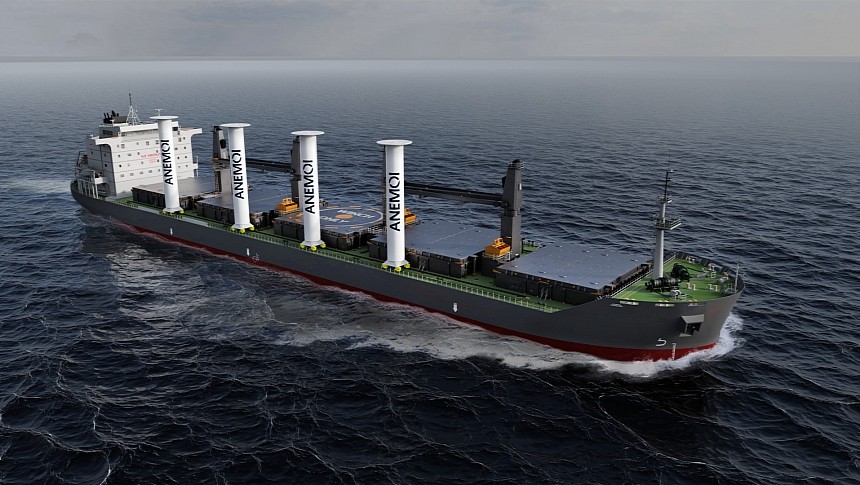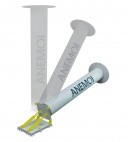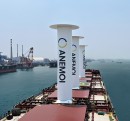Today’s sail systems are one of the most successful examples of how the latest technology can be used to harness natural sources of energy for clean transportation. One of these innovative approaches was recently selected for a UK grant.
The UK is serious about promoting and accelerating alternative technologies for a cleaner maritime industry. UK Shore (UK Shipping Office for Reducing Emissions) is an Innovate UK program worth more than £200 million. The Clean Maritime Competition Round 4 (CMDC4) is an important part of UK Shore, funded by the UK Department for Transport (DfT).
Innovative ship and boat designs were supported through the CMDC, and now it was time for a rotor sail system that could have a wider impact on the shipping industry. The system comes from Anemoi Marine Technologies, which recently received a grant of more than £1 million.
Anemoi plans to use the funding specifically for developing a rotor sail design with a 3.5-meter (11.4 feet) diameter and a 24.5-meter (80.3 feet) height. This smaller diameter version will be compatible with a wider range of vessels compared to its previous 5-meter (16.4 feet) design.
Anemoi's 5-meter rotor sails with three optional lengths are already a commercial success. The new version will expand the technology to mid-range vessels, from chemical and product tankers to RoRos. According to Anemoi, developing and testing the Rotor Sail with a 3.5-meter diameter is going to be a year-long process that will involve numerous industry partners.
Rotor Sails aren't new. They've been around since the mid-1900s when Anton Flettner invented the so-called "Flettner Rotors." Over the decades, the basic technology continued to evolve. Like traditional sails, it helps reduce fuel consumption and overall bunker costs. Yet, compared to these, it also magnifies thrust per square meter of sail area. This makes rotor sails more cost-efficient than traditional wind propulsion and more compatible with commercial shipping because they don't get in the way of standard operations.
The Anemoi rotor sails also feature what is claimed to be a first-of-its-kind longitudinal rail deployment system. In a nutshell, these rotor sails can be moved easily along the deck without interfering with cargo operations in any way.
The sails were also designed to minimize weight – modern, lightweight, highly engineered composites were used as the basic material. At the same time, they are rugged enough to operate even in the harshest water conditions and in winds of up to 70 knots (35 meters/second). With an additional control system that can be placed on the vessel's bridge, the Anemoi rotor sails can also become fully automated. Flexibility is another advantage that allows this innovative technology to be implemented on both existing and new-generation commercial vessels.
Through technologies such as this one, the UK intends to fully decarbonize its maritime sector by 2050.
Innovative ship and boat designs were supported through the CMDC, and now it was time for a rotor sail system that could have a wider impact on the shipping industry. The system comes from Anemoi Marine Technologies, which recently received a grant of more than £1 million.
Anemoi plans to use the funding specifically for developing a rotor sail design with a 3.5-meter (11.4 feet) diameter and a 24.5-meter (80.3 feet) height. This smaller diameter version will be compatible with a wider range of vessels compared to its previous 5-meter (16.4 feet) design.
Anemoi's 5-meter rotor sails with three optional lengths are already a commercial success. The new version will expand the technology to mid-range vessels, from chemical and product tankers to RoRos. According to Anemoi, developing and testing the Rotor Sail with a 3.5-meter diameter is going to be a year-long process that will involve numerous industry partners.
Rotor Sails aren't new. They've been around since the mid-1900s when Anton Flettner invented the so-called "Flettner Rotors." Over the decades, the basic technology continued to evolve. Like traditional sails, it helps reduce fuel consumption and overall bunker costs. Yet, compared to these, it also magnifies thrust per square meter of sail area. This makes rotor sails more cost-efficient than traditional wind propulsion and more compatible with commercial shipping because they don't get in the way of standard operations.
The Anemoi rotor sails also feature what is claimed to be a first-of-its-kind longitudinal rail deployment system. In a nutshell, these rotor sails can be moved easily along the deck without interfering with cargo operations in any way.
The sails were also designed to minimize weight – modern, lightweight, highly engineered composites were used as the basic material. At the same time, they are rugged enough to operate even in the harshest water conditions and in winds of up to 70 knots (35 meters/second). With an additional control system that can be placed on the vessel's bridge, the Anemoi rotor sails can also become fully automated. Flexibility is another advantage that allows this innovative technology to be implemented on both existing and new-generation commercial vessels.
Through technologies such as this one, the UK intends to fully decarbonize its maritime sector by 2050.






